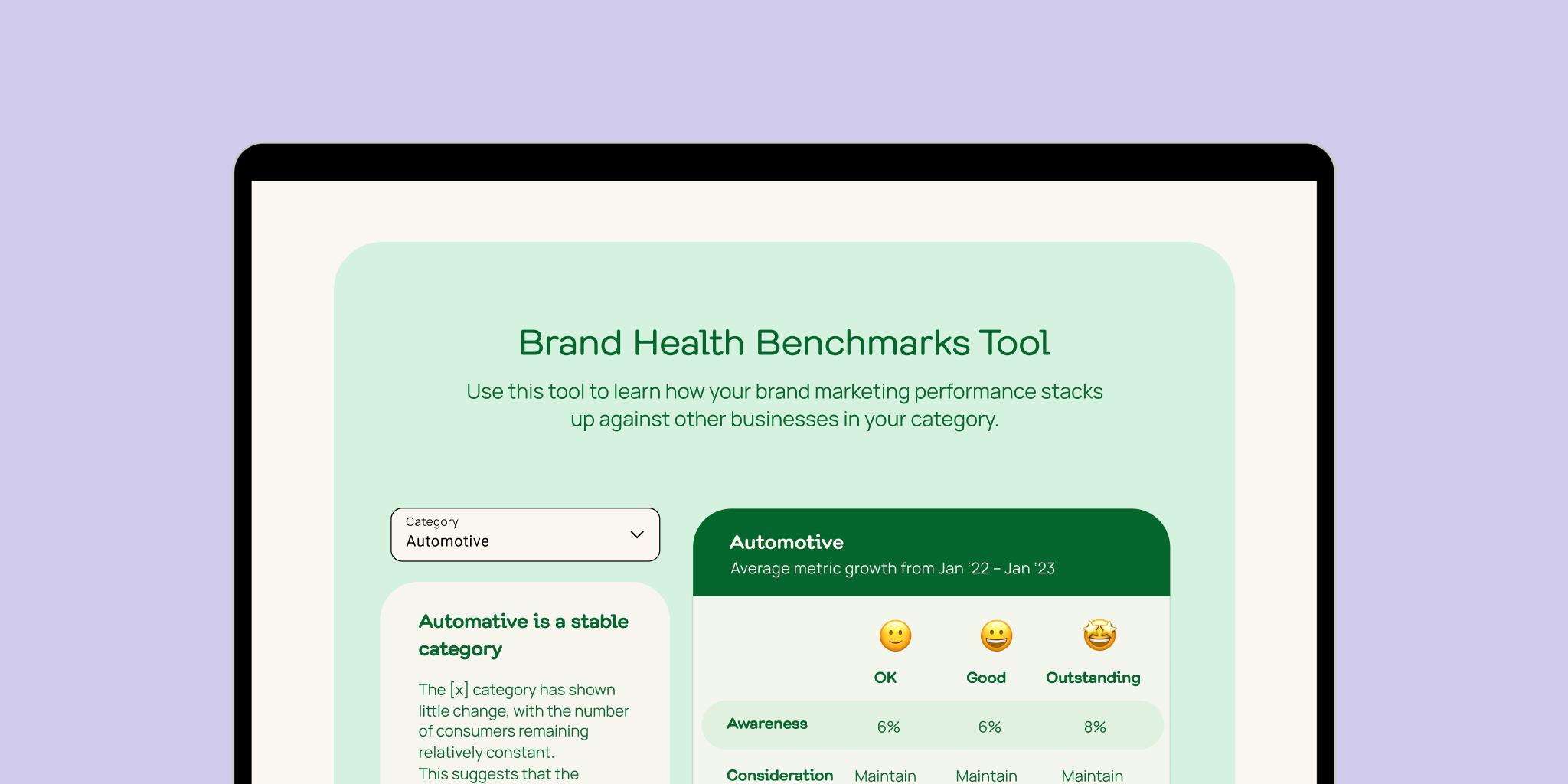How to use your Brand Benchmarks to win

Here at Tracksuit, we give marketers the tools they need to thrive and prove the value of their work. We’ve harnessed our large database of brand data into 73 industry-specific benchmarks so that brand champions everywhere can access annual brand benchmarks for their category.
Brand growth benchmarks are data points to help you understand what good growth looks like and whether you are currently sitting above, below, or on average compared to the other brands in your industry. These are global benchmarks, calculated using the data from brands around the world.
Because you wouldn’t know how good a marathon time is without knowing what’s considered best in class, right?
The brand metrics we have calculated annual growth benchmarks for are:
- Awareness: The percentage of people who are aware of you in your category
- Consideration: The percentage of people who consider purchasing your brand in your category
- Preference: The percentage of people who prefer your brand over the rest in your category
To create these global brand benchmarks, we’ve compiled:
- 6,075 data points; from
- 781,615 survey responses; across
- 1,440 brands with at least 1 year’s worth of data.

Rather than relying on a single year's data, we have smoothed out volatility by averaging benchmarks across multiple years. For example, if brand awareness in the yogurt category increased by 5% in the first year and 3% in the second, our average benchmark would be a balanced 4%.
This method smooths out yearly fluctuations, such as those we saw during the COVID-19 pandemic, giving you a more reliable metric to guide your strategy.
If you haven’t already, take the Benchmarks Tool for a spin, then return back here to find out what to do with your benchmarks once you’ve got them in hand.
Without much further ado, let’s look at how you can use these benchmarks to win.
Sign up to Shorts
For fortnightly brand insights, stories and goodness that'll help you win (we promise).
How to read your brand benchmarks
Your benchmarks indicate what level of growth could be considered OK, Average, Good & Outstanding over a rolling annual period compared to the rest of your category.
This means if you use the benchmark tool in August 2024, you should use those benchmarks to set goals for the 12 months ahead, rather than the remainder of 2024 - it would be unrealistic to hit an annual growth benchmark in less than six months!
Similarly, if you have a Tracksuit dashboard, when comparing the growth you have already achieved to your benchmark, you should consider the previous 12 months of data. In this example that would be from August 2023 - August 2024, not 2024 data only.
If your brand health metrics are equal to those in the Outstanding column, it means you’re in the top 10% of growth, if they’re the same as Good, it means you’re in the top 25% of growth, and OK means you’re in the top 50% of growth.
You might notice when you use the tool that some benchmarks don’t show a percentage, but rather state ‘Maintain.’ What this means is that maintaining your current level of the brand metric in question is an acceptable outcome and this may be common in highly competitive categories like FMCG. Do be aware that ‘maintaining’ a metric like awareness doesn’t mean resting on your laurels, or shutting up the marketing shop (horror!). You’ll still need to maintain your current level of activity and spend, otherwise you risk your brand metrics falling.
How to interpret your brand benchmarks
The best way to give colour to your benchmarks is to compare it to your own brand growth data on the Timeline view in the Tracksuit dashboard.
Do: Look at 12 months worth of data to meaningfully compare your growth to your benchmarks.
If you have increased your awareness by 3% over the past year (the average growth across 12 months), and can identify a consistent trend at this higher level of awareness, then you can be confident you’ve hit your goal.

Don’t: Look at a few months of growth to conclude you’ve hit your annual benchmark.
If you have increased your awareness by 4% from July to September (see the example below) and your benchmark says 4% for a year is considered outstanding, it may be too early to conclude you have hit your benchmark until you can see a consistent trend at this higher level of awareness, without notable monthly fluctuations.

So, now onto the juicy part: how can you use these benchmarks to grow?
1. To set achievable goals 🎯
Benchmarks mean you can say goodbye to guesswork about what level of brand growth is considered good for your category. Use them to set your own goals for the year ahead, as well as to set realistic expectations for the rest of your team.
Without the context these benchmarks provide, you could easily set yourselves up for disappointment. Like setting an annual goal to increase your awareness by 8%, when really an increase of 5% is considered outstanding for your category!
To pair benchmarks with your actual performance, you can track the shifts in your brand metrics on the Tracksuit dashboard. The Timeline view will be your go-to, providing clear oversight on how your awareness, consideration, usage and preference are evolving over time. When the time comes to compare your brand’s growth against benchmarks, the data is right there for you to see!

2. To plan and evaluate your brand campaigns 🔍
Now that you know what outstanding growth in a year looks like for your category, you can aim for the stars by having a better understanding of what's achievable within a campaign. Use your benchmarks to develop attainable campaign key results and measure your performance against them.
With Tracksuit, it's easier than ever to see how your brand campaigns shift your funnel metrics.
In the Timeline dashboard, you can drop in a milestone to mark when a campaign begins (and ends) and watch how your brand metrics evolve with always-on data.
You can easily attribute brand growth to the campaigns you run and justify your brand investment to stakeholders (and show how your performance is strong compared to competitors via the Brand Benchmarks). That's right, legend – prove the power of brand 🙌
3. To get board buy-in 🤝
Traditionally, one of the biggest challenges marketers have faced is the lack of reliable data to help them attribute commercial outcomes to all their hard work. In meetings with C-Suite and management, you might often see a heavy reliance on numbers and calculations to guide strategic discussion, and ultimately, final decisions. We feel your pain!
By using brand benchmarks, you have data on hand to give context to your brand marketing activity and understand what’s achievable within your next phase of growth.
A 2% increase in preference in a year might not sound like much, but if it's considered outstanding compared to competitors in your category, then your board will be grinning, not shaking their heads in disappointment.
Just like a 0% shift in consideration need not raise alarm bells. If your category is declining, even maintaining your position could be considered a win. We’d like to see you try to claim that without using brand benchmarks!
Taking a step back to consider the category-wide picture and even bringing benchmark data along to your stakeholder meetings is a great step towards making them a consistent part of your brand management and planning.
If you use Tracksuit, it’s easy to download your brand metrics from the Funnel page to share in your reporting and to take along to important meetings. Pair them with your Brand Benchmarks to make a formidable pair to prove the value of your work in context.
Not tracking your brand yet? We can help with that 👋
Brand benchmarks are the most useful when you can meaningfully compare them to your own brand growth data.
Tracksuit is brand tracking software built for ambitious consumer brands. Our beautiful, affordable and always-on dashboard helps marketers to measure and communicate the value of their brand.
The finishing line 🏁
Getting your Brand Benchmarks is just the beginning. Coupled with your own brand growth data, you’ve got some serious evidence on your hands to keep fighting for what you love (brand building!)
To recap, here are all the ways you can use your benchmarks::
- Provide context to your brand growth
- Set achievable goals
- Plan and evaluate your campaigns
- Get board buy-in on the value of your brand
Happy brand building! 🏋️



